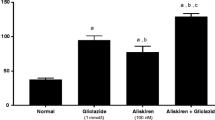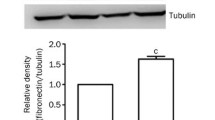Abstract
Aims: To investigate the effects of renin-angiotensin system (RAS) blockade on islet structure and function in diabetic rats, and its mechanisms. Methods: Diabetic rat models were created by high-fat high-caloric laboratory chow plus small dose (30 mg/kg) streptozotocin ip injection. After 8-week intervention with perindopril (AE, no.=10) or valsartan (AR, no.=10), all the animals’ islet function was evaluated by iv glucose tolerance test. Pancreases were stained by immunohistochemistry technique to qualitative and/or quantitative analysis the content of insulin, inducible nitric oxide synthase (iNOS), transforming growth factors-β1 (TGF-β1) in islets. The apoptosis of islet cells was detected by transferase-mediated dUTP nick-end labeling dUTP nick end labeling (TUNEL). The expression level of angiotensinogen (AGT) and insulin mRNA in islets were detected by RT-PCR. Results: Compared with normal control group (NC, no.=10), area under the curve of insulin from 0 to 10 min (AUCI0–10) of diabetes group (DM, no.=8) was decreased by 66.9%, the relative expression of local AGT was increased by 69.2%, the insulin relative concentration (IRC) of β-cell and the expression of insulin mRNA were decreased significantly, the amount of apoptotic cells in unit islet area was increased by 2.1 times, the relative content of iNOS and TGF-β1 positive cell relative volume (TRV) was increased by 23.0% and 2.52 times, respectively (all p<0.01). Compared with DM group, AUCI0–10 of AE and AR group was increased by 41.4% and 33.2%, respectively; the relative expression of local AGT was decreased by 21.4% and 23.4%, respectively; IRC and the expression of insulin mRNA were increased significantly; the amount of apoptotic islet cells was decreased by 79.0% and 36.2%, respectively; the relative content of iNOS was decreased by 16.5% and 18.9%, respectively; TRV was decreased by 43.8% and 35.6%, respectively (all p<0.01). There were no significant differences between group AE and AR. Conclusion: Blockade of RAS may improve diabetic rats islet function via the amelioration of intra-islets oxidative stress, fibrosis and apoptosis.
Similar content being viewed by others
References
Andraws R, Brown DL. Effect of inhibition of the renin-angiotensin system on development of type 2 diabetes mellitus (meta-analysis of randomized trials). Am J Cardiol 2007, 99: 1006–12.
Hansson L, Lindholm LH, Niskanen L, et al. Effect of angiotensin-converting-enzyme inhibition compared with conventional therapy on cardiovascular morbidity and mortality in hypertension: the captopril prevention project (CAPPP) randomized trial. Lancet 1999, 353: 611–6.
Dahlöf B, Devereux RB, Kjeldsen SE, et al. Cardiovascular morbidity and mortality in the losartan intervention for endpoint reduced in hypertension study (LIFE): a randomized trial against atenolol. Lancet 2002, 359: 995–1003.
Scheen AJ. Renin-angiotensin system inhibition prevents type 2 diabetes mellitus. Part 1. A meta-analysis of randomized clinical trials. Diabetes Matab, 2004, 30: 487–96.
Tahmasebi M, Puddefoot JR, Inwang ER, Vinson GP. The tissue renin-angiotensin system in human pancreas. J Endocrinol 1999, 161: 317–22.
Huang Z, Jansson L, Sjöholm A. Pancreatic islet blood flow is selective enhanced by captopril, irbesartan and pravastatin, and suppressed by palmitate. Biochem Biophys Res Commun 2006, 346: 26–32.
Kranzhöfer R, Schmidt J, Pfeiffer CA, Hagl S, Libby P, Kübier W. Angiotensin induces inflammatory activation of human vascular smooth muscle cells. Arterioscler Thromb Vasc Biol 1999, 19: 1623–9.
McDaniel ML, Kwon G, Hill JR, Marshall CA, Corbett JA. Cytokines and nitric oxide in islet inflammation and diabetes. Proc Soc Exp Biol Med, 1996, 211: 24–32.
Tikellis C, Wookey PJ, Candido R, Andrikopoulos S, Thomas MC, Cooper ME. Improved islet morphology after blockade of the renin-angiotensin system in the ZDF rat. Diabetes 2004, 53: 989–97.
Kato Y, Miura Y, Yamamoto N, Ozaki N, Oiso Y. Suppressive effects of a selective inducible nitric oxide synthase (iNOS) inhibitor on pancreatic beta-cell dysfunction. Diabetologia 2003, 46: 1228–33.
Abuissa H, Jones PG, Marso SP, O’Keefe JH Jr. Angiotensin-converting enzyme inhibitors or angiotensin receptor blockers for prevention of type 2 diabetes: a meta-analysis of randomized clinical trials. J Am Coll Cardiol 2005, 46: 821–6.
Cooper ME, Tikellis C, Thomas MC. Preventing diabetes in patients with hypertension: one more reason to block the renin-angiotensin system. J Hypertens Suppl 2006, 24: S57–63.
Eprosartan dual action offers clinical benefit for elderly and overweight hypertensives. Cardiovasc J S Afr 2004, 15: 91–2.
Rincon-Choles H, Kasinath BS, Gorin Y, Abboud HE. Angitensin II and growth factors in the pathogenesis of diabetic nephropathy. Kidney Int Suppl 2002, 82: 8–11.
Leask A, Holmes A, Abraham DJ. Connective tissue growth factor: a new and important player in the pathogenesis of fibrosis. Curr Rheumatol Rep 2002, 4: 136–42.
Abreu JG, Ketpura NI, Reversade B. Connective tissue growth fator (CTGF) modulates cells signaling by BMP and TGF-beta. Nat Cell Biol 2002, 4: 599–604.
Kaneto H, Kawamori D, Matsuoka TA, Kajimoto Y, Yamasaki Y. Oxidative stress and pancreatic beta-cell dysfunction. Am J Ther 2005, 12: 529–33.
Yang C, Chao J, Hsu WH. The effect of bradykinin on secretion of insulin, glucagon, and somatostatin from the perfused rat pancreas. Metabolism 1997, 46: 1113–5.
Author information
Authors and Affiliations
Corresponding author
Rights and permissions
About this article
Cite this article
Yuan, L., Li, X., Xu, G.L. et al. Effects of renin-angiotensin system blockade on islet function in diabetic rats. J Endocrinol Invest 33, 13–19 (2010). https://doi.org/10.1007/BF03346544
Accepted:
Published:
Issue Date:
DOI: https://doi.org/10.1007/BF03346544




